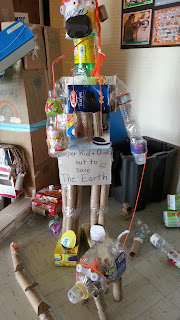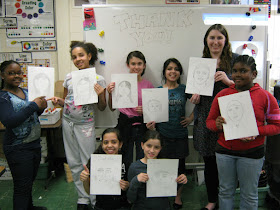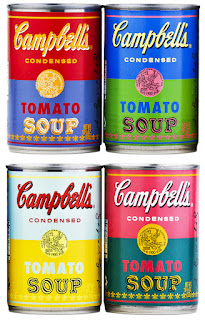As a traveling teacher, it becomes tricky to fit in using technology in the art class...but if used correctly, technology is the key tool to help promote your department and your students' accomplishments.
How can I document my art class if I have a cart or drive from school to school?
Have you ever considered bringing your phone with you from class to class while pushing your cart from room to room? Normally, I would have shunned the idea. I would have been in fear of students stealing the phone, dropping it off the cart, or parents and the school being afraid that I was taking photos of students for my own use. Instead, I use my phone for instant access to promoting my art curriculum. After taking photos of student work, I email them to my school account, or post the student artwork on Twitter to share with the art education community.
If you are still uncomfortable with the idea of using your phone (especially because it is a GREAT responsibility), try bringing your digital camera, and uploading images of student work on your own! The
iPevo digital camera is also another great tool of technology that immediately takes pictures and uploads them into the computer (affordable).
Using the iPevo camera can help in instant access of student artwork onto Artsonia, or any social media networks you use to promote your curriculum.
Although I do not currently own an iPad (I'm working on a fundraiser for one for the art program), there are plenty of resources on how iPads are used in the art room. Even a simple web search can lead you to multiple links and resources on its many positive uses, including documenting student work and uploading projects for Artsonia or other project sites.
Why take photos in the art room?
Sharing photographs of your student projects and lessons you teach is a great way to promote your curriculum and advocate for the visual arts in education. It is a great power to have to share with the nation and local community. It's immediate access, and saves you from extra work of finding more display spaces beyond your already jam-packed display responsibilities.
What do I have to do to protect myself and my students?
But as said in the Spiderman movie,
With Great Power Comes Great Responsibility. Before taking any action of promoting your program in your room or on a cart, take the steps to protect yourself and your students.
In the beginning of the school year, parents sign forms to approve or deny any video or photography of their children for school events or local papers. In my schools, once we gather all the forms, we have a list of students who can or cannot be photographed during that school year.
With that said, you can begin documenting (but be careful of adding student names). Take every precaution in protecting the student's full identity.
During open house, inform parents that you photograph as well to promote the art program. Be open with the parents. If need be, send out a second form for yourself to inform parents of your intentions. Tell them of any sources you may post, such as Artsonia, your blog, Twitter, or even your website. If you present at conferences, even discuss how photos are used to share projects and curriculum with colleagues to improve professional development.
How can I use social media while at work?
One example: When I received a display case from
Art Room Aid, I could not wait to show off how we could use the case for displaying student artwork in the school. As I pushed my cart with sculpture projects to the case, I set it up, closed the door, locked the case, pulled out my phone, took pictures, and while my principal was nearby, I showed him how I uploaded the image straight to Twitter, tagging
Art Room Aid and hash-tagging #artsed. I explained that by doing so, I just shared my documentation and gratitude for receiving the cabinet with Dick Blick by publicly thanking them, and hash-tagging the post to share our accomplishment with the art education community. The teachers are now very used to me watching around taking photos of bulletin boards and displays with my phone after I set them up.
Facebook also helps us to connect, even if we only accept friends and family. By joining art teacher "groups," we connect to share our own stories of successes and challenges, promote our contests and programs, and help each other answer general questions. We even post those photos we take with our phones and digital cameras to share student artwork (while being responsible).
The same goes for Google +, where you can use live chat hangouts to communicate (similar to Skype). I've used this during school to interview artists and have students ask questions to artists who work in the field (good way to promote careers in art!)
(Creating caricature drawings after interviewing Cliff Roth on Google +, a well known speed paint artist in the site!)
With Blogger, we can create our own blogs, follow other blogs and view recent posts, but with the help of other social networks, we can instantly post a link of our blog entries for others to view instantly. When I finish this post, I will take the extra steps to share the link on Pinterest, Twitter, Facebook, and Google+ to promote it. Yes, I've whipped out blog posts during my plan time.
Depending on your school district, you may have access to social networks, or not at all. In my district, I can access Artsonia, Twitter, Google +, LinkedIn, and Pinterest. All can be great resources to access during the day, but be mindful to use it for professional purposes, not checking what your friends are up to or what recipe to find for dinner tonight.
I use social media to promote my art program. I share pictures of artwork, bulletin boards, blog posts, and article I find in Art education resources. I protect my students' identities by not adding names, and barely any faces unless the image was used for local newspapers or school newsletters. Since I am an elementary teacher, I do not encourage students to use social sites in the classroom simply because our district does not use social media with the K-6 students. Many students in grades 3-6 have their own Facebook, Instagram, or Twitter accounts, but with walking that fine line of safety and responsibility with students, we choose not to cross those boundaries.
Depending on the load you balance, there are many positive ways to use social media with students in Jr. High and High School, and in being a part of the art education social media, I have seen many ways students are properly using technology in the art room.
If you read this entire post hoping for ways you can access social media for student use, I apologize if I misled you. At the elementary level and with the multiple responsibilities I juggle traveling, I do not feel that I have the focus to fully monitor students on social media in my art classes. It's a powerful tool that requires more attention than I can give. However, since I am a part of a PLN, I know of other teachers who have experimented with social media in their classrooms.
What is a "PLN?"
There are many public networks that teachers use to share ideas and promote their departments, and in doing so, they are participating in a "Professional Learning Network (PLN)." The #artsed PLN on Twitter has been a wonderful resource in meeting art teachers across the country who are strong advocates with many brilliant ideas. We share images of student work, videos of activities ( and how-to's of projects), and post questions on handling of materials.
According to Wikipedia, A professional learning network is an informal learning network that consists of the people a learner interacts with and derives knowledge from in a personal learning environment. In a PLN, a person makes a connection with another person with the specific intent that some type of learning will occur because of that connection. In my case, I interact with other art educators across the country. I promote by program, share my projects and ideas, and in return, I learn a great deal of how to becoming a stronger advocate in the arts and a leader in art education. By being a part of a social media art teacher group or visiting the #artsed hash-tag, you are an active part of a PLN.
(Remember this picture? We're the #artsed PLN that met at the NAEA convention in Ft. Worth last month!)
Be Safe, Be Respectful, Be Responsible. Key words in our elementary schools to promote a positive learning environment, and the same goes with social media. But as much as I warned to be careful, don't hesitate to take the risk to share your program. Without technology, you may feel like a teacher stuck in a storage closet with a cart, feeling left out with no support. With technology, you are a strong advocate for art education and your school's program. Let other art teachers know who you are. We want to meet you and see what you do to promote the arts in your schools.


















































